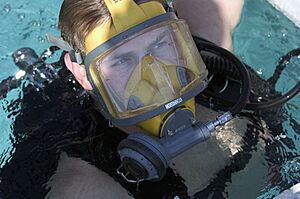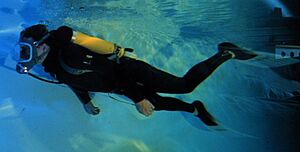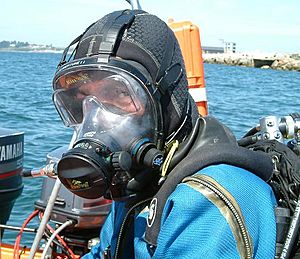Full-face diving mask facts for kids

The AGA Divator full face mask is used by military and civilian divers
|
|
| Other names | Band-mask |
|---|---|
| Uses | Provision of breathing gas, underwater vision, and sometimes communications for underwater divers |
| Inventor | Yves le Prieur |
| Related items | Diving helmet, Diving regulator, Diver communications, Diving mask |
A full-face diving mask is a special type of diving mask. It covers a diver's entire face, keeping water out. This mask helps divers see clearly underwater. It also protects their face from cold water, dirty water, or stings from sea creatures like jellyfish.
These masks are safer than just using a mouthpiece. If a diver passes out or has a problem, they can still breathe. This is because the mask stays securely on their face.
Full-face masks are often used by professional divers. These are people who dive for work. They are not as common for recreational diving, which is diving just for fun.
Contents
Staying Safe with a Full-Face Mask
Some full-face masks have a special valve. This valve lets the diver switch between breathing from their air tank and breathing air from the surface. It is called a "dive/surface valve." Divers can easily use this valve, even with thick gloves on.
A full-face mask offers a more secure way to breathe underwater. This is very important if there is a chance a diver might lose consciousness. The mask stays sealed, keeping the air supply steady.
The clear part of the mask, called the faceplate, is very strong. It is made from a tough plastic. This faceplate is securely attached to the mask's soft edges. Many masks also have a mouthpiece inside. This is a backup in case water gets into the mask.
Not every mask will fit every diver perfectly. This is because people have different face shapes and sizes. But most divers can find a mask that seals well for them. Divers can also "purge" the mask. This means they can push any water out of it while still underwater.
How Full-Face Masks Were Invented
The first full-face diving mask was invented in 1933. It was created by a person named Yves le Prieur.
An early type of full-face mask was sometimes called a Jack Browne rig. This name came from a DESCO engineer. He designed one of the first masks that had a constant flow of air from the surface.
Cool Facts About Full-Face Diving Masks
- Many full-face masks have curved lenses. This helps divers see more underwater than with flat lenses.
- With a regular scuba diving mask, divers often have to bite down on a mouthpiece. This can cause jaw pain over time. Full-face masks solve this problem because there is no mouthpiece to bite.
- Divers can talk to each other better with a full-face mask. This is because they are not biting down on a mouthpiece, which makes communication easier.
- Full-face masks usually fog up less inside than regular diving masks.
- In cold water, a full-face mask keeps a diver's face much warmer. A regular mask leaves most of the face exposed.
- Full-face diving masks do not have a snorkel attached to them.
- For divers with mustaches or beards, full-face masks are a great choice. They cover the whole face, making it easier to get a good seal.
- It takes longer to clear water from a full-face scuba diving mask than from a regular one.
- Divers wearing full-face masks might get tired faster. This is because the mask makes their head more buoyant (it floats more). They have to work harder to stay in the correct swimming position.
- Full-face masks are usually more expensive than regular scuba masks.
See Also
- Self-contained breathing apparatus: Many of these devices use full-face masks.
- Gas mask: Most gas masks are also full-face masks.
- Diving helmet: An older type of diving gear that covers the whole head.
- Diving mask: The basic mask used for seeing underwater.




